In response to the emerging serialisation mandates and requirements, Acsis has worked with Cognex to deliver a serialised packaging data management solution. Acsis chief technology officer, John DiPalo, explains how vision systems are key to such solutions.
To prevent counterfeit drugs from finding their way into the hands of consumers, pharmaceutical regulators around the world are in the process of establishing stricter regulations for pharmaceutical manufacturers, co-producers, distributors and retailers. At the same time, pharmaceutical manufacturers want to improve traceability to prevent counterfeiting and isolate the source and extent of safety and quality control problems.
To respond to the emerging serialisation mandates and requirements, Acsis worked with Cognex to deliver a serialised packaging data management (SPDM) solution, designed to convert demand from the pharmaceutical manufacturer’s enterprise resource planning (ERP) system to drive individual packaging lines and production cells.
Serialisation using SPDM is introduced throughout the manufacturing and packaging process by integrating with existing equipment. Smart camera vision systems are a small but critical component used extensively in the serialisation solution not only to validate the presence, accuracy and readability of the various labels but also to ensure product safety and package integrity.
Regulators have been working for years to develop a standard for a secure electronic version of the chain-of-custody of pharmaceuticals, often called ePedigree. Within a few years from now, ePedigree requirements are expected to affect all pharmaceutical plants around the world.
Beyond compliance, pharmaceutical manufacturers are interested in preventing counterfeiting, stopping parallel trade through unauthorised channels and achieving greater visibility into how products are made, distributed and used.
They see improved traceability as a way to minimise production and distribution of unsafe or poor quality products and reduce the potential for recalls. In the event of a recall, a granular tracing system helps minimise the amount of product that needs to be recalled.
upgrading packaging lines
The challenge for the pharmaceutical industry is in upgrading its huge installed base of manufacturing equipment to comply with imminent serialisation requirements. Acsis, a developer of pharmaceutical warehousing and distribution solutions, has addressed this challenge by developing a robust data management system for serialised product to meet current and future national, international, and customer mandates, while also enabling the benefits that serialisation can bring to the production and control processes.
The Acsis SPDM solution comprises six distinct stages that can be implemented in total or independently of each other, based on the serialisation requirements of the implementation:
- Stage 1: Bottle identification and verification
- Stage 2: Label printing and verification
- Stage 3: Bottle and label cross-referencing
- Stage 4: Bundle aggregation
- Stage 5: Case aggregation
- Stage 6: Pallet aggregation
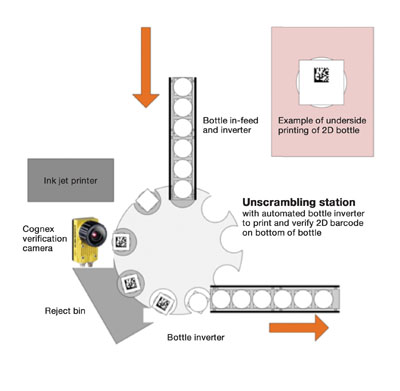
Figure 1: Empty unit printing at the unscrambling station
Stage 1 involves printing a unique 2D barcode directly onto the container using an assigned, randomised identity. Typically, the integrated bottle unscrambling station is upgraded to provide bottle inversion to enable underside printing with an inkjet printer. A Cognex In-Sight 5400 ID reader is used to verify the accuracy and readability of the barcode. Missed or faulty printed units are immediately rejected. The SPDM solution has the capability of displaying the images of all reads in near real-time on the human machine interface (HMI) as the data is captured.
‘We have used Cognex vision systems extensively in this SPDM solution,’ says John DiPalo, chief technology officer for Acsis. ‘The key advantage of Cognex vision systems is that they integrate the camera, image processing hardware and software into a single compact enclosure that can be easily combined with existing processing equipment. Cognex In-Sight Explorer software is used to configure the vision system to read the label and measure its readability according to industry standards without any programming and this functionality has been seamlessly integrated into the Acsis SPDM solution.’
Generally, current vision systems are divided into two groups: PC-based and self-contained smart camera vision systems, such as those made by Cognex. Compared with PC-based systems, smart camera vision systems are generally easier to configure, validate and maintain. Because they are solid state, smart camera vision systems intrinsically provide a more stable platform than Microsoft Windows-based alternatives, requiring less maintenance and fewer service pack updates and patches to install. Being configurable rather than programmable, smart camera vision systems can also make it easier for manufacturers to accommodate future changes in regulations and standards.
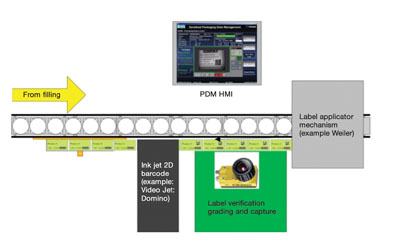
Figure 2: Label verification
In Stage 2, an inline printer prints a unique serial number on each of a long web of labels. Another Cognex In-Sight 5410 vision system reads each label and verifies its accuracy and readability. In an upcoming version of SPDM the ID reader will also read the text and perform a complete quality check on the label. If the label passes the verification, it is applied to the bottle.
Then a series of processing stages, such as insert/outsert verifications, seals etc., are performed that have no direct bearing on serialisation, yet are critical to product safety and package integrity.
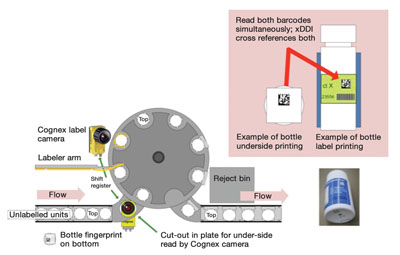
Figure 3: Cross-referencing the bottle/unit identifier to the label identifier
Stage 3 involves associating the bottle/unit identifier to the label identifier. The bottle or other packaging unit is presented to an array of at least two vision systems in such a way that the bottle/unit identifier and the label identifier are captured simultaneously and presented to the SPDM solution as a joined entity.
Based on the joined data, the SPDM system verifies that the bottle/unit identifier and label data are valid. If there are inconsistencies, the system sends a reject signal. The association of the bottle/unit and label is utilised in downstream processing steps and potentially in other areas.
aggegation stages
Stage 4 is the bundling aggregation stage where bottles/units are combined into a bundle or a case and the individual containers are aggregated to the bundle or case. The 2D barcode that was applied in Stage 1 makes it possible to identify containers after they have been aggregated into a bundle or case. The SPDM solution sends a print job to the bundle or case label applicator to identify the aggregated unit.
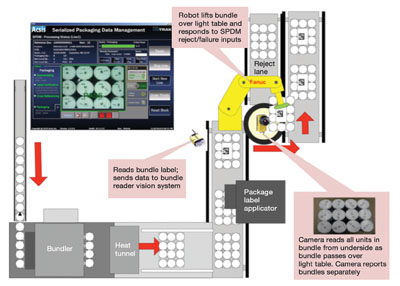
Figure 4: Bundling station
If bundling is used, the bundle is wrapped and shrinked; then the formed bundle passes by a label applicator. The applicator applies a label to the top of the bundle that includes a barcode of the bundle identifier.
The robot then lifts the bundle and presents it as a single instance to a Cognex In-Sight 5605 5 Megapixel vision system, which can capture images from up to 24 bottles using direct lighting. The vision system takes a single picture of the underside of the bundle and returns a full list of all units read on the image. It reads and verifies each bottle/unit identifier against the database, compares successful reads to the expected bundle size, and then aggregates the associated label serial numbers to a unique bundle identifier. A barcode reader reads the individual barcode of each bundle.
If all expected units are read, the SPDM system will pass the bundle. If any of the expected units are not accounted for or if any of the barcodes are missing or illegible, the vision system will return a fail and the robot will place the bundle on the reject conveyor.
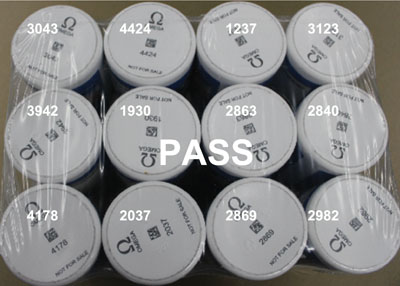
Figure 5: Underside of bundle
Stage 5, consisting of case/shipper aggregation, can be performed at any location as long as the database can be accessed from the processing location. The operator indicates the state of an aggregation process, such as case packaging, and scans each bundle identifier applied during Stage 4. When the case is completed, the operator ends the session, which sends the case-level print job to a label printer. The label can be applied manually to the case or automatically by a label applicator. A barcode reader scans the label and the SPDM solution returns an error/reject message if an unrecognised bundle identifier is read or if the identifier is not correctly associated to the packaging order.
Stage 6, which can be performed at a remote location, provides pallet aggregation. The operator indicates the state of an aggregation process, scans each case identifier applied in Stage 5, and when the pallet is completed, ends the session and sends a pallet label print job to a label printer. Again, a barcode reader scans the label and the SPDM solution returns an error/reject message if an unrecognised bundle identifier is read or if the identifier is not correctly associated to the packaging order.
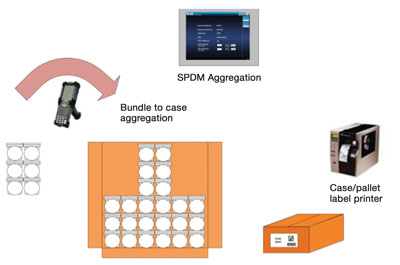
Figure 6: Case aggregation
‘The Acsis SPDM solution is currently an extension to our ProductTrak for Life Sciences solution that is installed at several major pharmaceutical companies,’ DiPalo says.
‘This extension of the solution into the packaging area provides a cost-effective and easy-to-implement way to incorporate data serialisation into new and existing packaging lines while maintaining existing machine speed and quality. Cognex vision systems play a critical role in our SPDM solution by providing a compact, fast, and accurate method of reading and verifying the quality of 2D barcodes.’




